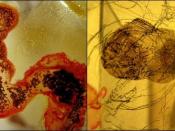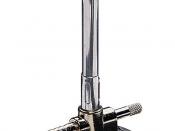AIM: to practice using some sterile techniques, to examine a range of micro-organisms found in air macroscopically and to examine a range of micro- organisms found in food and water macroscopically
APPARATUS:
Incubator
Sterile nutrient agar plates
1. 3 water samples
2. 1 air sample
3. 3 food samples
Bunsen burner
Sterile pipettes
Inoculating loops
Sticky tape
Marking tape
Water samples(various)
Yoghurt
Inoculating needle/ probe
Mould from fruit, vegetables or bread
Methylated spirits
RISK ASSESMENT:
1. Glassware - can cause cuts if handled incorrectly
2. Bunsen burner - can cause burns if not on safety flame
3. Methylated spirits - toxic if ingested, highly flammable. Skin irritant
4. Although the micro-organisms used in the activities in this manual are considered 'safe', standard microbiological procedure requires that they are regarded as potentially harmful
SAFETY PROCEDURES:
1. Handle with care, do not leave glassware near the edge of the bench
2. take care, do not leave flame unattended keep flammable liquid i.e.
Methylated spirits away
3. Keep Methylated spirits away from flames. Wear gloves when handling it
4. Wear gloves, lab coat and safety glasses. All used equipment should be placed in disinfectant. Dispose of cultures after use, in an autoclave. Wash hands before leaving lab. Never open agar plate after setting up
METHOD:
1. Sterilise the workbench area by swabbing alcohol on to it
2. collect 8 sterile nutrient agar plates
3. A sample of fresh milk was obtained
4. leave one plate aside, sealed and taped as the control
5. Using a sterile inoculating loop, a small sample of the fresh milk was streaked onto the plates. This plate was then sealed with sticky tape and labeled as fresh milk
6. Steps 3 and 4 were then repeated with tap water, distilled water, fish tank water, fresh milk, old milk,



Opinion
i like the way of description
0 out of 0 people found this comment useful.